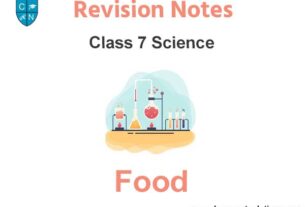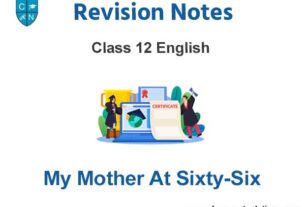Please refer to Respiration Class 7 Science notes and questions with solutions below. These revision notes and important examination questions have been prepared based on the latest Science books for Class 7. You can go through the questions and solutions below which will help you to get better marks in your examinations.
Class 7 Science Respiration Notes and Questions
RESPIRATION
The process of taking oxygen into the cells, using it for enrgy release & then eliminating the waste
products like CO2 & H2O is known as respiration.
It is a very slow process. A number of enzyme help in the process of respiration.
BREATHING
The process of taking in O2 rich air into the lungs & giving out carbon dioxide rich air is known as breathing.
Breathing process include 2 steps –
• Inhalation :
The process of taking in air is called inhalation.
• Exhalation :
Giving out of air is called exhalation.
Breathing involves only exchange of gases.
DIFFERENCE BETWEEN BREATHING & RESPIRATION

There are 2 types of respiration
◈ Aerobic respiration :
• In this types of respiration complete oxidation of glucose take place & CO2, H2O & Energy are released.
• Aerobic respiration takes place in the presence of oxygen & is carried out in the bodies of almost all
living animals & plants

◈ Anaerobic respiration :
• In anaerobic respiration, there is incomplete oxidation of glucose CO2, ethyl alcohol & energy are the
end products.
• Anaerobic respiration takes place in the absece of oxyen.

• Yeast & some bacteria show anaerobic respiration.
• Anaerobic respiration in microorganism present in food & alcohol causes fermentation.

ANAEROBIC RESPIRATION IN HUMAN
• During excessive physical exercise, anaerobic respiration takes place in muscle to produce lactic acid.
• The accumulation of lactic acid in the muscle cause fatigue & pain.

RESPIRATION IN PLANTS
• Like all other living organisms, plants also respire for their survival. They also take in oxygen from the
air and give out carbon dioxide. During this process most of the plants use atmospheric oxygen to
break down glucose into carbon dioxide and water with the release of energy.
• In plants, breathing takes place through tiny holes or openings called stomata present under the
leaves. Stomata traps air and the exchange of gases takes place inside the plant cells.
◈ Stomal Apparatus :
• A stomatal opening surrounded with two guard cells and several subsidiary cells is called stomatal
apparatus. The opening and closing of the stomata is brought about by the expansion and contraction
of the guard cells. Guard cells expand and contract due to the flow of water in and out of the cells.
The exchange of gases in plants is not as fast as in animals.

• Plant roots also respire. Roots take in oxygen from the air present between the soil particles.
• Some of the woody stems take in air through openings called lenticels.

RESPIRATION IN ANIMALS
• Respiration through moist skin
Eg. Frog & Earthworm
• Respiration through cell membrane
Eg. Amoeba
• Respiration through Spiracles
Eg. Cockroach
• Respiration through gills
Eg. Fishes

RESPIRATION SYSTEM OF HUMAN
The respiratory system in human beings concsists of the following organs
◈ Nasal Cavity :
• Air enters the nose through the nostrils and reaches the nasal cavity.
◈ Larynx :
• The nasal cavity leads into the pharynx. From the pharynx air passes into a rectangular chamber called
larynx

◈ Trachea :
• The trachea or wind pipe is a delicate muscular tube situated in the front of the neck. It is 12 cm in
length and 2.5 cm in diameter. The trachea divides into two bronchi.
◈ Bronchi :
• Each bronchus leads to the lungs of its own side. Each bronchus then branches into smaller tubes
known as bronchioles. They end in tiny globules called air sacs or alveoli where exchange of gases
takes place.
◈ Lungs :
• Lungs are two in number and are present in the chest cavity of the body. Air sacs are richly supplied
with blood vessels. When air enters the lungs, the blood takes in oxygen and gives out carbon dioxide
and water
• Blood carries oxygen to all parts of the body from the lungs.
• When we exhale, the carbon dioxide rich air follows the reverse route finally moving out through the
nose as shown below.

MECHANISM OF BREATHING
• Breathing takes place with the help of the intercostal muscles between the ribs and the diaphragm.
When we breathe in, the intercostal muscles contract and the ribs are pushed outwards. The chest
cavity becomes larger and the air rushes into the lungs.
• During breathing out, the intercostal muscles relax and the ribs move inwards. The chest cavity shrinks
and the air containing carbon dioxide is pushed out of the lungs.

• Breathing rate : The number of times a person breathes in a minute is termed as the breathing rate.
The normal breathing rate in adult at rest ranges from 12 to 20.

Olympiad Problems NCERT Class 7 Respiration
Question: The air sacs at the end of the smallest air tubes inside the lungs are called.
(A) alveoli
(B) bronchi
(C) bronchioles
(D) larynx
Answer:
alveoli
Question: Glucose is oxidised to ethyl alcohol in –
(A) aerobic respiration
(B) anaerobic respiration
(C) fermentation
(D) none of these
Answer:
anaerobic respiration
Question: Normal range of breathing rate in an average adult person at rest is –
(A) 9 to 12
(B) 15 to 18
(C) 12 to 20
(D) 30 to 33
Answer:
12 to 20
Question: Plants get their oxygen requirement for respiration through –
(A) stomata
(B) lenticels
(C) both (A) and (B)
(D) None of these
Answer:
both (A) and (B)
Question: Which one of the following can respire in the absence of oxygen? –
(A) fish
(B) frog
(C) yeast
(D) Man
Answer:
yeast
Question: An animal breathe through skin as well as lungs is –
(A) frog
(B) Earthworm
(C) snail
(D) fish
Answer:
frog
Question: Air tube of an insect is called –
(A) Spiracle
(B) larynx
(C) pharynx
(D) gills
Answer:
Spiracle
Question: During inhalation the diaphragm moves –
(A) upwards
(B) downwards
(C) towards left
(D) towards right
Answer:
downwards
Question: During exhalation the ribcage moves –
(A) upward and outward
(B) downwards and inwards
(C) from side to side
(D) does not move at all
Answer:
downwards and inwards
MCQs for NCERT Class 7 Science Respiration
Question: Respiration is the process in which –
(A) energy is stored in the form of ADP
(B) energy is released and stored in the form of ATP
(C) energy is not released at all
(D) energy is used up
Answer:
energy is released and stored in the form of ATP
Question: Which of the following is the source of respiration –
(A) Stored food
(B) Fats
(C) Glucose
(D) Proteins
Answer:
Stored food
Question: The form of energy used in respiration is –
(A) Chemical energy
(B) Electrical energy
(C) Mechanical energy
(D) Radiant energy
Answer:
Chemical energy
Question: Which one is anabolic process?
(A) Respiration
(B) Digestion
(C) Photosynthesis
(D) Ascent of sap
Answer:
Photosynthesis
Question: A catabolic process is –
(A) Absorption of minerals
(B) Ascent of sap
(C) Respiration
(D) Assimilation
Answer:
Respiration
Question: What is wrong about respiration
(A) It does not occur in cell
(B) Oxidation occurs without the use of enzymes
(C) Energy is released in one step quickly
(D) All the above
Answer:
All the above
Question: In anaerobic respiration in plants:
(A) O2 is taken in
(B) O2 is given out
(C) CO2 is taken in
(D) CO2 is given out
Answer:
CO2 is given out
Question: Stomata open during day time because the guard cells:
(A) are thin walled
(B) are bean shaped
(C) have to help in gaseous exchange
(D) photosynthesize and produce osmotically active sugars or organic acids
Answer:
photosynthesize and produce osmotically active sugars or organic acids
Question: Which one of the following is the link between glycolysis and Kreb’s cycle?
(A) Phosphoenolpyruvic acid
(B) Fumaric acid
(C) Citric acid
(D) Acetyl Co-A
Answer:
Acetyl Co-A
Question: Exchange of gasses occurs through
(A) Stomata
(B) Lenticels
(C) Root surface
(D) All the above
Answer:
All the above
Question: Vocal cords occur in
(A) pharynx
(B) glottis
(C) bronchii
(D) larynx
Answer:
larynx
Question: In man, which of the following structures is analogous to the spiracles of cockroach?
(A) Alveoli
(B) Lungs
(C) Bronchioles
(D) Nostrils
Answer:
Nostrils
Question: Which of the following prevents collapsing of trachea?
(A) Diaphragm
(B) Ribs
(C) Cartilaginous discs
(D) Muscles
Answer:
Cartilaginous discs
Question: A normal man respires in a minute
(A) 10-15 times
(B) 14-18 times
(C) 20-25 times
(D) 25-30 times
Answer:
14-18 times
Question: Lungs have a large number of alveoli for
(A) having spongy texture and proper shape
(B) more surface area for diffusion of gases
(C) more space for increasing volume of inspired air
(D) more nerve supply
Answer:
more surface area for diffusion of gases
Question: Presence of large number of alveoli around alveolar ducts opening into bronchioles in mammalian lungs is
(A) inefficient system of ventilation with little of residual air
(B) inefficient system of ventilation with high percentage of residual air
(C) an efficient system of ventilation with no residual air
(D) an efficient system of ventilation with little residual air
Answer:
an efficient system of ventilation with little residual air
Question: Which one of the following structures closes the respiratory passage during ingestion of food?
(A) Larynx
(B) Epiglottis
(C) Hard palate
(D) Soft palate
Answer:
Epiglottis
Question: The covering of lungs is called
(A) pericardium
(B) pleural membrane
(C) perichondrium
(D) peritoneum
Answer:
pleural membrane
Question: The narrowest and most numerous tubes of lungs are termed as
(A) bronchus
(B) alveoli
(C) bronchioles
(D) hilum
Answer:
bronchioles
Question: The exchange of gases in a mammal takes place in
(A) trachea
(B) bronchioles
(C) bronchii
(D) alveoli
Answer:
alveoli
Question: A person having high fever may be breathing faster than normal. The reason for this faster breathing is due to
(A) additional need of O2 for germs
(B) mental worry of the patient
(C) high temperature of body
(D) loss of appetite
Answer
high temperature of body
Question: When diaphragm of man is completely dome shaped it shows
(A) end of expiration and beginning of inspiration
(B) beginning of expiration and end of inspiration
(C) increased rate of breathing
(D) decreased rate of breathing
Answer:
end of expiration and beginning of inspiration
Question: Which one of the following events takes place during inspiration in man?
(A) The internal intercostal muscles relax
(B) Due to contraction of external intercostal muscles and flattening of diaphragm the volume of thoracic
cavity increases
(C) Due to contraction of external intercoastal muscles, and flattening of diaphragm the volume of thoracic
cavity decreases
(D) The abdominal muscles contract
Answer:
Due to contraction of external intercostal muscles and flattening of diaphragm the volume of thoracic
cavity increases
Question: Which one of the following binds with haemoglobin irreversibly?
(A) Carbon dioxide
(B) Carbon monoxide
(C) Ethane
(D) Nitrogen
Answer
Carbon monoxide
Question: Asthma is a respiration disease caused due to
(A) infection of trachea
(B) infection of lungs
(C) bleeding into pleuro cavity (D) spasm in bronchial muscles
Answer:
spasm in bronchial muscles

We hope the above Respiration Class 7 Science are useful for you. If you have any questions then post them in the comments section below. Our teachers will provide you an answer. Also refer to MCQ Questions for Class 7 Science


